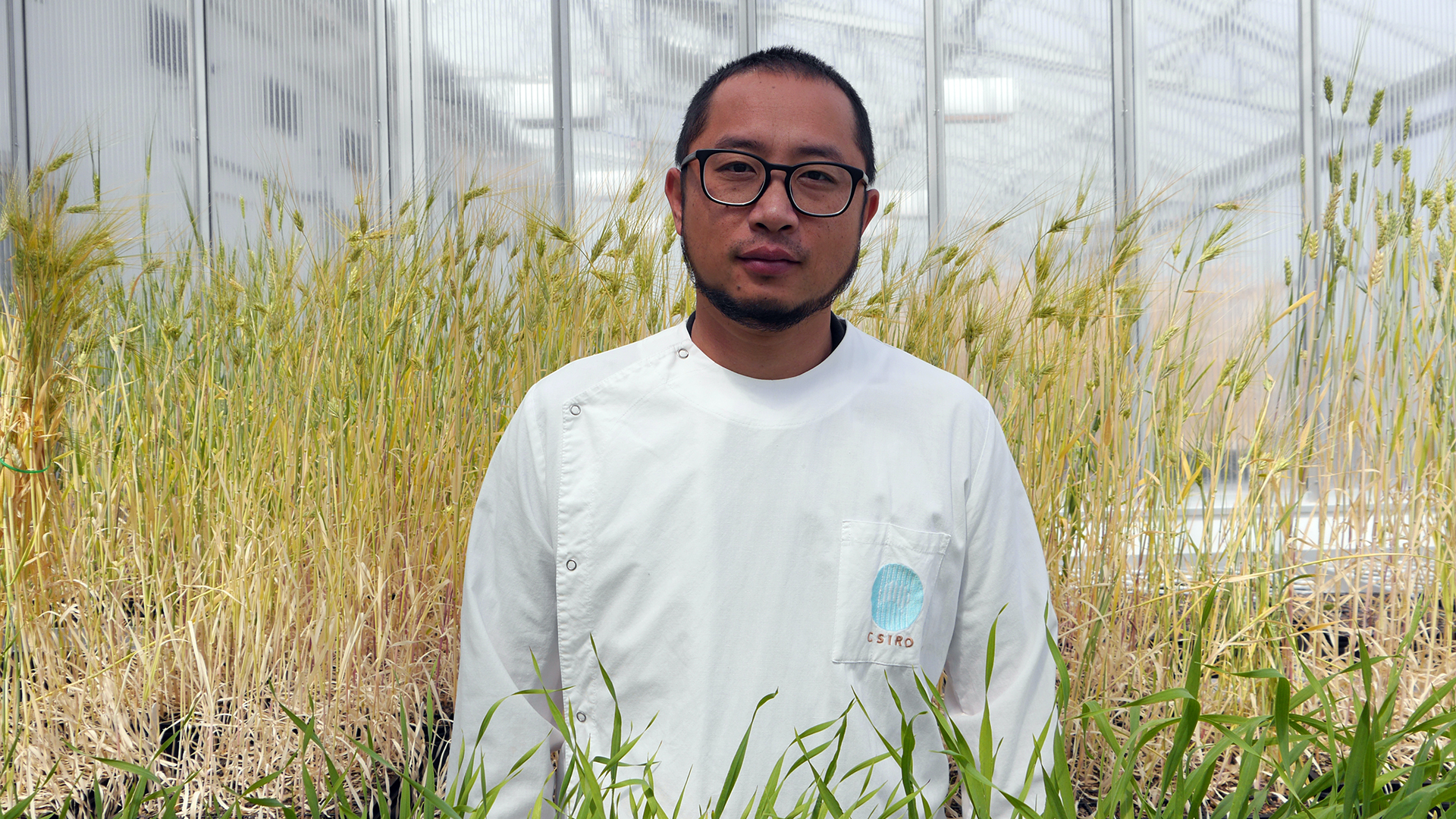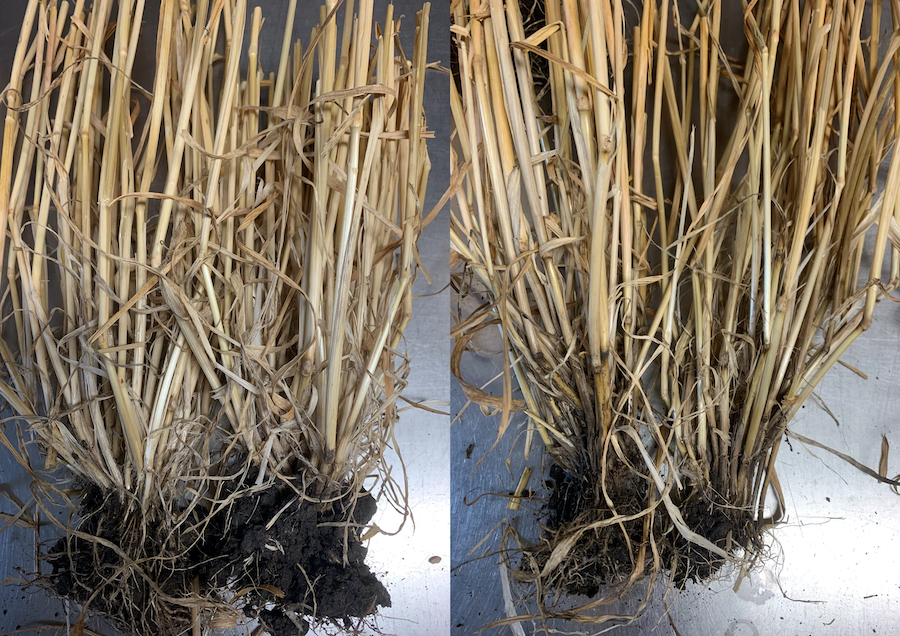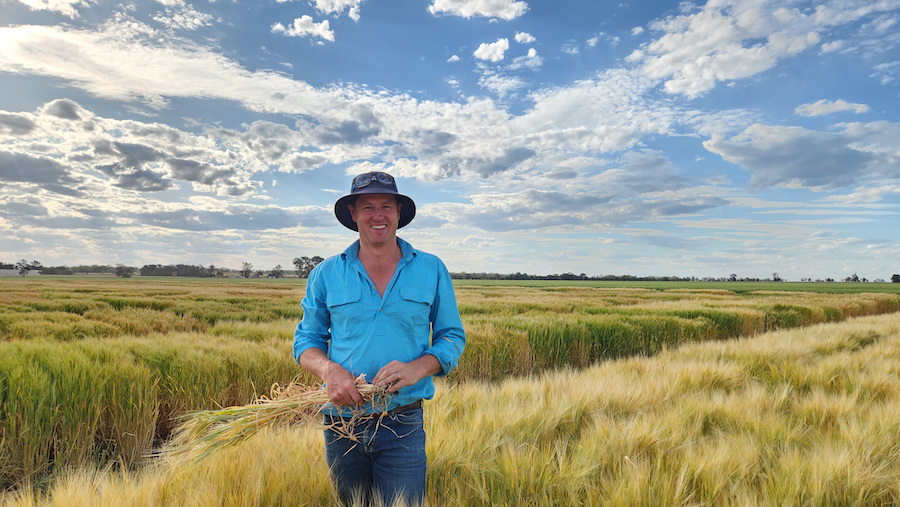As is becoming standard at the cutting edge of agricultural innovation, a combination of technologies from different disciplines is breaking through previously recalcitrant agricultural challenges.
In the latest example, the target is the disease Fusarium crown rot (FCR) in wheat.
Australian Grain Technologies (AGT) wheat breeder Dr Phil Davies half-jokingly refers to this integrated approach as “the kitchen sink strategy”.
It involves GRDC investments across pre-breeding, breeding and agronomy. These investments are aligned in such a way as to create an innovation chain that is reducing yield losses and making ongoing gains possible into the future.
The pre-breeders
Dr Chunji Liu’s CSIRO team demonstrated that despite the extremely challenging screening challenges, it is possible to genetically map and characterise FCR resistance genes.
The genes they identified – typically from germplasm already used in Australian cultivars – revealed one of the reasons FCR is so problematic for grain growers. The genes individually only deliver small or ‘minor’ levels of resistance.
The process of mapping these genes, however, generated DNA markers that allow genes to be stacked (or combined) and deployed together.
Following characterisation of the resistance material, the four best-performing genes were combined in wheat lines adapted to each of the three Australian growing regions. These CSIRO lines with four stacked resistance genes have moved on to breeders.
Preliminary field trials estimate that the stacked genes can reduce stem browning due to FCR by about 30 per cent.
Needless to say, the CSIRO team – now led by Dr Zhi Zheng – is further exploiting the genetic angle.

Dr Zhi Zheng leads a CSIRO team developing Fusarium crown rot resistance in cereals. Photo: CSIRO
In a new GRDC investment, a resistance gene first identified in China called Fhb7 has been brought into Australia. Dr Zheng has mapped the gene and developed DNA markers to aid in its selection. The team also added Fhb7 to the lines already containing four stacked FCR resistance genes.
In 2022, the effects of Fhb7 underwent single-plant testing before progressing to single-row trials in 2023. Seed will also undergo bulking in 2023 in preparation for plot trials in 2024 with the best-performing lines.
Trial sites for this new material have been selected in Canberra, Narrabri in New South Wales, and Gatton in Queensland. A site in Toowoomba, Queensland, is also under consideration.
“The field trials in 2024 will provide opportunities to select lines that perform best in the different environments and ensure no linkage drag has occurred that could negatively impact yield,” Dr Zheng says. “Testing to date is demonstrating that reductions in disease severity and inoculum levels are possible.”
In the meantime, Dr Zheng’s team is also expanding its search for novel resistance genes. This involves screening for additional sources of resistance genes, with work underway in bread wheat, as well as barley and durum wheat given its particular susceptibility to crown rot.
“We are also testing the feasibility of re-creating barley resistance genes using gene editing while also exploring other mechanisms that could aid in providing FCR resistance, such as drought tolerance and tillering capabilities,” Dr Zheng says.
Overall, the crop losses associated with FCR of wheat to the Australian grains industry is expected to be $404 million per year. The new varieties produced using the outputs of this CSIRO-led project are expected to increase resistance from MS (moderately susceptible) to MR (moderately resistant) and reduce yield losses by more than 7 per cent under crown rot pressure.

Fusarium crown rot disease severity is reduced in a wheat line containing the Fhb7 Fusarium crown rot resistance gene (left) compared to a current Australian variety (right). Photo: CSIRO
The breeders
In a canny move by the breeding sector, they opted not to run parallel commercial-in-confidence investigations. Instead, AGT has stepped up to process and characterise (or phenotype) the partially resistant lines on behalf of the sector. This was made possible by a second GRDC investment within the integrated FCR strategy.
AGT’s Dr Davies explains that the key factor driving their research design is the need to broaden the understanding of this material to include both ‘resistance’ and ‘tolerance’ metrics, plus how these interact. Resistance is the metric often used by pre-breeders for their selections and is based on observation of stem browning, including in glasshouses. Tolerance is paddock-based and generates data about the gene’s impact on yield in the presence of FCR infection.

AGT’s Dr Phil Davies heads a project to understand how best to select for Fusarium crown rot tolerance and resistance in the paddock for use in breeding programs. Photo: AGT
Making the shift from resistance to tolerance, however, is far from a trivial task: “The more traits you need to put together in a breeding program, the harder it becomes,” Dr Davies says.
“Adding in FCR resistance is then especially challenging because phenotyping for crown rot resistance in paddock trials is notoriously difficult. We have to deal with strong environmental effects while attempting to detect partial resistance levels that do not provide a clear resistance reaction.”
In the past, these complications meant that phenotyping for FCR has been expensive and time-consuming for breeders. To minimise costs, it has typically been done later in the breeding cycle when there are fewer breeding lines and a lot of the starting genetic diversity has been lost.
This project allowed the AGT breeder to disrupt that constraint by developing a high-throughput, efficient and cheaper strategy that can detect the lines most worth promoting for FCR resistance very early in a breeding cycle.
“Breeding is a numbers game,” Dr Davies says. “If you can do something at scale early on then you can make a difference exploiting the available genetic diversity.”
This work is underway at Narrabri, where conditions are optimal for FCR studies in typical years. Dr Davies has put the CSIRO lines through field trials designed to understand the gene’s yield benefit. He is also developing surrogate measures for selecting the best-performing lines during breeding.
He dubs the strategy he uses as a cross between the ‘kitchen sink’ and ‘fast fail’ methods. The approach amounts to a willingness to try anything and everything in their power to phenotype for FCR. This included deploying off-the-shelf remote sensors to collect data throughout the season, in addition to measuring yield and screening levels.
At the same time, the ‘fast fail’ method involves a readiness to stop wasting resources on things that are not working and reassign them to things that are.
Data from imaging and near-infrared (hyperspectral) technology are some of the avenues he has explored.
Promising results have been obtained from canopy temperature data. He has compared data from replicate plots that did and did not receive FCR inoculum and has detected a potential surrogate signal for FCR tolerance. The tolerance signal is being validated during the 2023 season. Analysis of fungal mass in tillers using PREDICTA® B was used to provide baseline readings of the extent of FCR infection present in the trial plots.
The hyperspectral avenue is especially exciting to Dr Davies as it brings machine learning into the phenotyping process in the form of algorithms that can process, detect and quantify tolerance extremely efficiently.
“Machine learning is a way to increase the throughput and rigour of otherwise time-consuming and subjective phenotyping,” he says. “Another use for machine learning is in the detection of white heads from imaging data. This data, too, can also be useful to monitor impacts and tolerance to Fusarium head blight.”
At this stage, he is not trying to identify what these surrogate signals are measuring in terms of plant physiology. Rather, he is looking for correlations that allow him to efficiently phenotype for crown rot resistance and tolerance in the paddock in order to breed for commercially useful trait combinations.
The work is very much focused on outcomes in the paddock, but that has resulted in a setback. The last couple of years have delivered seasons that were mild, with unusually soft finishes. While these conditions were favourable for growers, they have resulted in low levels of crown rot disease. For example, very few white heads were detected in the trial plots in 2022.
To make the most of the last year of trials in 2023 (which is delivering a hot, dry finish), AGT is running six trials. These are spread from Trangie in central NSW to Formartin in Queensland.
He is also ramping up the quality of the sensors used to measure canopy temperature.
The ‘fast fail’ method previously saw him deploy a thermal camera linked to a mobile phone, which was mounted on the back of a ute. It was inched up and down the trial site by Dr Davies, who also operates any drones used by the project.
“There are some interesting signs that canopy temperature may prove useful in streamlining selections for crown rot tolerance,” he says. “So, while the ute proved useful in the past in order to throw the kitchen sink at crown rot, we are retiring it now that we have a promising signal in favour of a UAV (unmanned aerial vehicle) platform that allows for a massive gain in throughput efficiency.”
So, he started basic. He threw the kitchen sink at the problem and now has allocated the resources to the things that work.
At the six trial sites, everything is done in paired plots, with and without inoculum. There are 60 bread wheat varieties in the trials, 24 barley varieties and 12 durums. The varieties were selected to span from susceptible through to both resistant and tolerant.
The plots were additionally sown to minimise maturity differences as these can impact on disease pressure.

AGT’s phenotyping trials have been underway in Narrabri, NSW, where conditions are optimal for crown rot studies. Photo: AGT
Ultimately, the goal is to produce a method that allows the entire breeding sector to routinely and efficiently test and breed for increased crown rot tolerance.
“The way I look at it is that the pre-breeding work is really valuable,” Dr Davies says. “We are excited about it and want it to keep going. This project is designed to make the best use of that material to help all the breeding companies deliver those genetics to growers’ paddocks. All we are doing is trying to increase the efficiency of that delivery.”
Dr Davies is also keen to create a new understanding about the relationship between resistance and tolerance with regards to crown rot. “Hopefully at the end of this project we’ll have a better understanding of the relationship between resistance and tolerance in ways that create further opportunities to get on top of crown rot. We might even end up with a situation similar to root lesion nematodes, where both resistance and tolerance are useful, but having them together is even better.”
With more material coming through from Dr Zhen’s pre-breeding work, what is envisioned here is a continuous phenotyping pipeline.
Integrated disease management
With only partial resistance flowing into the breeding pipeline, cereal plant pathologist Dr Steven Simpfendorfer of the NSW Department of Primary Industries (DPI) is working on every other opening to better control FCR, including independent evaluation of fungicide seed treatment options.
One key approach is to exploit a weakness within the FCR pathogen-disease cycle that allows growers to reduce the fungus’ spread and infectivity within paddocks.
“Fusarium crown rot does not form survival structure (spores) within the soil and, therefore, is not an especially mobile pathogen,” Dr Simpfendorfer says. “Instead, physical contact is needed between the pathogen – which survives between seasons as mycelium (cottony growth) within cereal stubble – and the new cereal crop.”
That means the fungus is stuck within the retained cereal stubble, predominantly above ground. The infection points are all below ground.
“If you cultivate, you bust that stubble up into smaller fragments and put it below ground where it can more readily infect cereal plants,” he says. “The coleoptile (protective sheath that encases the first shoot) is very susceptible to infection. So, you want to decrease the chance the coleoptile will come into contact with the fungus within fragmented cereal stubble below ground.”
For example, strategies such as inter-row sowing can be used to move the seed furrow – and therefore emerging cereal plants – away from inoculum concentrated in the previous cereal rows.
Cereal harvest height is another lever when a rotation includes lower-stature break crops, such as chickpeas. The pathogen can be dispersed across a paddock during the chickpea harvest process if retained and infected standing cereal stubble goes through the header when harvesting lower chickpea pods.
Since expression of FCR is all about moisture and temperature stress during grain fill, sowing time is another exploitable lever to minimise these stresses during this critical growth stage.
The second weakness is that crown rot is a ‘visual disease’, since it results in obvious white heads on infected plants. The white heads give away locations within individual paddocks where infected stubble can become problematic for crops when conditions favour the fungus.
This allows FCR control options to be targeted where they are needed using simple levers. For example, crop damage is amplified whenever the plant struggles to obtain the moisture needed to reduce canopy temperature during grain filling. Among the factors that exacerbate water stress is soil compaction and other pathogens, such as root lesion nematodes.
Understanding where the pathogen is within paddocks is critical and there are two options available for growers who want to fine-tune their monitoring. There is stubble plating available through NSW DPI at Tamworth. The other way is PREDICTA® B testing following the recommended protocol and adding stubble to the soil sample.
“PREDICTA® B will give results for a whole range of pathogens, which can be very useful in terms of understanding impacts on root development that can make expression of crown rot worse,” he says.
Once there is an understanding of pathogen levels, Dr Simpfendorfer recommends triaging paddocks according to the following scheme:
- The worst paddocks have to go to a non-host break crop.
- Paddocks with medium fungal loads that hold moisture well can be sown to barley or a more-tolerant bread wheat variety while looking at options such as inter-row sowing and planting at the start of the recommended window to reduce contact with the pathogen and disease expression, respectively. Durum must be avoided as it is highly susceptible.
- Paddocks without FCR inoculum can be sown to durum or more-susceptible bread wheat varieties.
Ensuring seed is free of Fusarium infection is also vital following wet seasons, such as 2022, which favour Fusarium head blight. Current recommendations place the cut-off for sowing Fusarium infected seed at five per cent. Since this advice was imported from the US, Dr Simpendorfer is currently validating the percentage that is best-suited to Australian conditions from Fusarium infected seed collected in 2022.
In terms of break crops, faba beans and canola are generally more effective than chickpeas, while sorghum is also an option in summer in the north. The break crop also needs to provide enough time for the cereal stubble to decompose and displace the Fusarium crown rot fungus. This can require a double break in some regions when infected stubble loads are high, as in southern NSW.
In addition, GRDC co-investment is making it possible for Dr Simpfendorfer to run varietal trials, on-farm validations of management options and seed treatment trials. The team also engages in communicating best-practice management options. The aim is to provide information that allows growers to understand what makes FCR worse or better within the context of any one particular farming system.
Field trials
The integrated disease management field trials are being conducted at seven sites in 2023. These range from Deniliquin in southern NSW to Westmar in Queensland.
One aspect of these field trials is looking at a fungicide seed treatment from Syngenta called VICTRATO®. This work aims to understand impacts on relative yield loss of a common commercial bread wheat variety across environments at the two recommended application rates.
Previous independent seed treatment trials were conducted across 18 sites over four seasons (2018–21). Results to date show a reduction in yield loss from FCR from an average of 21.5 per cent to 9.6 per cent using the new seed treatment at the lower recommended application rate. At the higher recommended rate, yield loss was further pushed down to 4.9 per cent.
“The upshot from a series of GRDC co-invested projects is that a regionally proven integrated disease management package exists that the new genetics can fit into to help further boost FCR control,” Dr Simpfendorfer says.
“None of the elements are a complete solution. Not the fungicides, genetics nor a single management strategy. But combinations are possible that deliver real benefits that hinge on avoiding practices that make FCR infection and expression a lot worse.”
More information: Zhi Zheng, zhi.zheng@csiro.au; Phil Davies, phil.davies@agtbreeding.com.au; Steven Simpfendorfer, steven.simpfendorfer@dpi.nsw.gov.au

























































